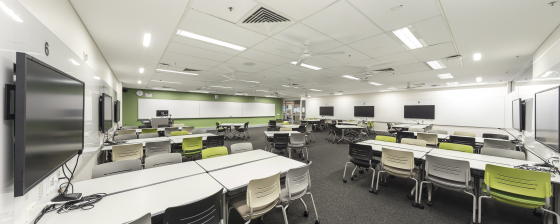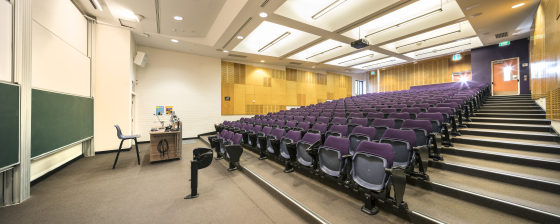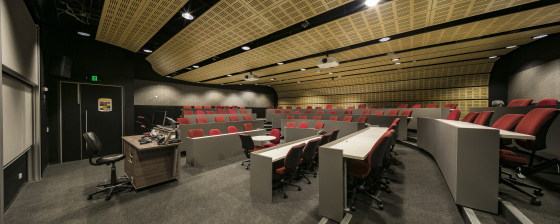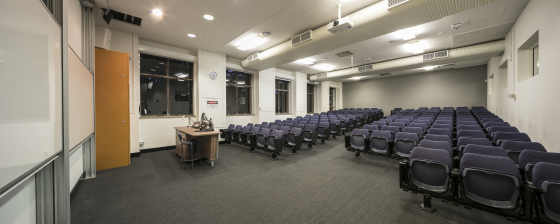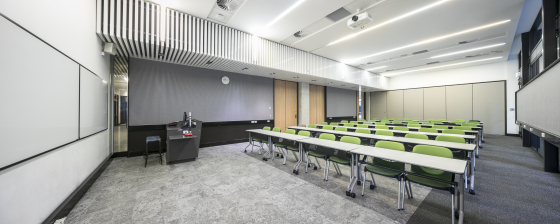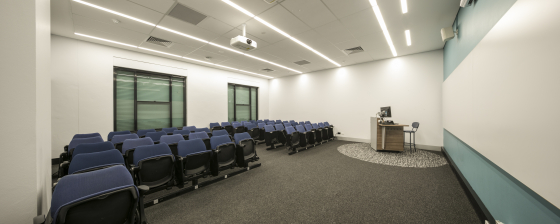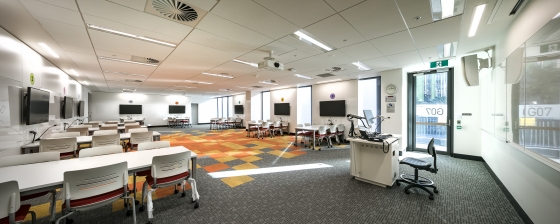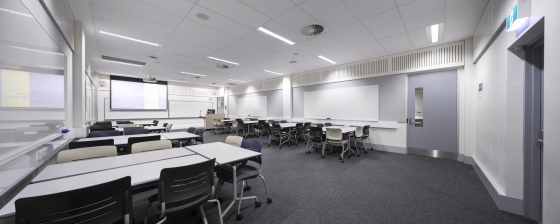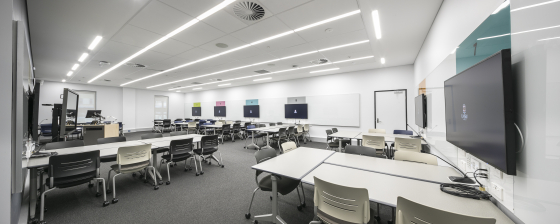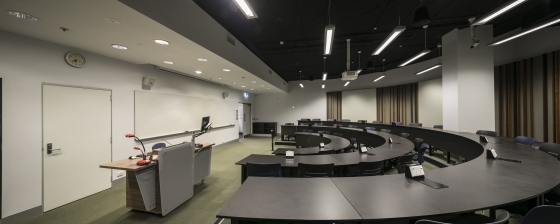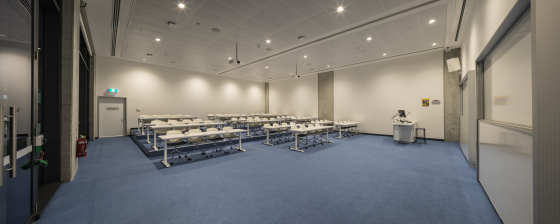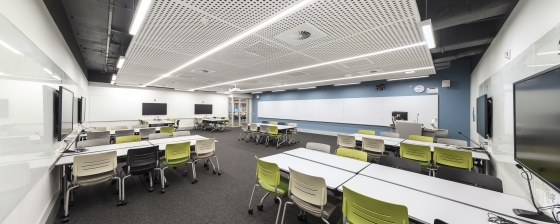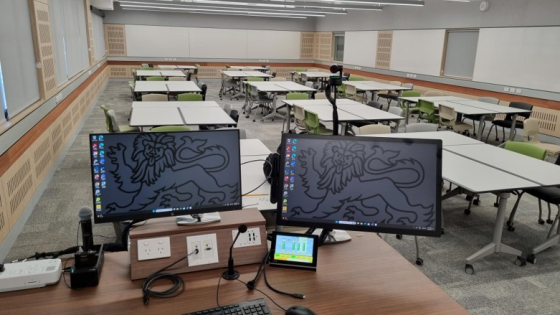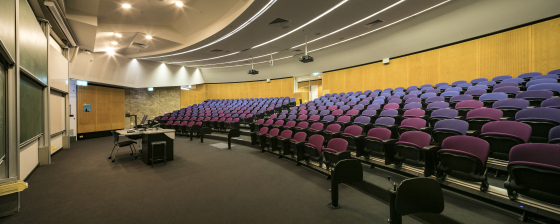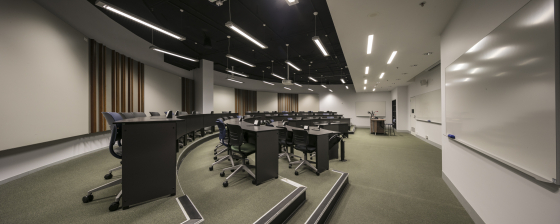Example of an Active Learning Space: Bioscience Room G07
Active learning spaces have been designed for staff and students to explore the ‘flipped classroom’ experience in greater depth. The flexible nature of these spaces supports collaborative, interactive and team-based learning. There are 85 Active Learning Spaces, currently located at UNSW’s Kensington campus, that have a flexible layout with moveable furniture which enables a variety of seating configurations.
The main physical features of Active Learning Spaces are:
- Flat Floor or Turn & Learn
- Moveable tables and chairs; Fixed tables and moveable chairs
- Whiteboards located both at the front and around the room
- Pod Monitors and Push to talk microphones located around the room (Interactive Hi- Tech Active Learning Spaces only)
- Able to accommodate small - medium classes (20- 85 students)
Types of Active Learning Spaces
Active Learning Spaces can be categorised further into four different room types:
- Collaborative (Low-Tech)
- Interactive (High-Tech)
- Turn & Learn: Harvard Style
- Turn & Learn: Tiered Floor with Moveable Seating
Read below to learn more about the different types of Active Learning Spaces that are available.
Collaborative (Low-Tech)
Example of a Collaborative (Low-Tech): Mathews Room 231
A type of Active Learning Space with a flat floor, moveable tables, and chairs, as well as whiteboards located on the walls at both the front of and around the room.
The tables and chairs are positioned throughout the room in groups and are located adjacent to the whiteboards on the walls, enabling students to engage and collaborate with their peers in groupwork activities such as presentations, problem solving etc.
The term ‘Low-Tech’ is commonly used in reference to Collaborative Active Learning Spaces because the technology available in the room is located at the lectern only, which for some rooms includes a web camera and USB microphone mounted on the lectern monitor, rather than around the room.
Interactive (High-Tech)
Example of an Interactive (High-Tech): Quadrangle Room 1043
A type of Active Learning Space with a flat floor, moveable tables and chairs which also includes additional technology such as Monitors located on the walls around the room and Push to Talk Microphones mounted on the wall underneath each Monitor.
The term ‘High-Tech’ is commonly used in reference to Interactive Active Learning Spaces because the technology available is located both at the lectern and all around the room forming ‘Pods’.
The tables and chairs are grouped around these ‘Pods’ to which a Monitor, a Push to Talk Microphone and whiteboards are co-located enabling students to participate in active class discussion or collaborate with their peers in groupwork activities.
Turn & Learn: Harvard Style
Example of a Turn & Learn Harvard Style: Business School Room 105
A type of Active Learning Space which has tiered levels, fixed ‘horseshoe style’ tables with moveable chairs, as well as whiteboards located on the walls at both the front of and around the room.
The configuration of a Turn & Learn Harvard Style room looks like a small lecture theatre that can accommodate small-medium classes (38 -53 students). The technology available in the room is located at the lectern only.
The horseshoe shape of the tables and moveable chairs enable students to be in close proximity and interact with each other. Students can turn their chairs to face and form groups with their peers who are sitting behind, adjacent and in front of them.
The location of the whiteboards around the room enables students to engage and collaborate in groupwork activities such as presentations, problem solving etc.
Turn & Learn: Tiered Floor with Moveable Seating
Example of a Turn & Learn: Tiered Floor with Moveable Seating: Science & Engineering Building Room G05
A type of Active Learning Space which has both tiered levels & a flat floor, fixed tables with moveable chairs, as well as whiteboards located on the walls at the front of the room.
The configuration of a Turn & Learn Tiered Floor with Moveable Seating room looks like a small lecture theatre that can accommodate small-medium classes (44 -68 students). The technology available in the room is located at the lectern only.
Each tiered floor level consists of a row of fixed tables with moveable chairs that enable students to be in close proximity and interact with each other. Students can turn their chairs to face and form groups with their peers who are sitting behind, adjacent and in front of them.
The flat floor configuration at the front of the room, allows the teacher and their students to actively engage and participate in learning activities such as Fishbowl Discussion, Gallery Walk, Roleplays & Simulations.
